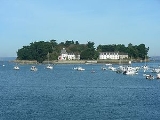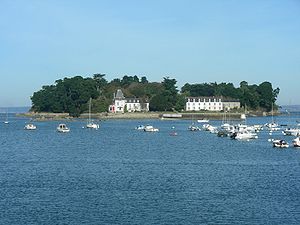
Tristan Island
Encyclopedia

Brittany
Brittany is a cultural and administrative region in the north-west of France. Previously a kingdom and then a duchy, Brittany was united to the Kingdom of France in 1532 as a province. Brittany has also been referred to as Less, Lesser or Little Britain...
. It is only about 450 m long and 250 m wide but despite its small size, it has a rich history, especially since the Middle Ages
Middle Ages
The Middle Ages is a periodization of European history from the 5th century to the 15th century. The Middle Ages follows the fall of the Western Roman Empire in 476 and precedes the Early Modern Era. It is the middle period of a three-period division of Western history: Classic, Medieval and Modern...
when a priory
Priory
A priory is a house of men or women under religious vows that is headed by a prior or prioress. Priories may be houses of mendicant friars or religious sisters , or monasteries of monks or nuns .The Benedictines and their offshoots , the Premonstratensians, and the...
was built there. In the 19th century, it became famous as the site of the first canning factory for sardines fished in the Bay of Douarnenez. It is also closely associated with Breton legends and the island of Ys
Ys
Ys , also spelled Is or Kêr-Is in Breton, and Ker-Ys in French , is a mythical city that was built on the coast of Brittany and later swallowed by the ocean...
. Now uninhabited, the island has become a nature reserve which is only accessible to tourists once or twice a year or by special arrangement with the local tourist office. At low tide, the island is connected to the mainland on the Douarnenez (or eastern) side of the estuary.
History
Tristan bears traces of civilization dating back to the Bronze AgeBronze Age
The Bronze Age is a period characterized by the use of copper and its alloy bronze as the chief hard materials in the manufacture of some implements and weapons. Chronologically, it stands between the Stone Age and Iron Age...
. The written history of the island begins around 1118 when, according to a charter dated 1126, Robert de Locuvan, bishop of Cornouaille, donated the Island of St Tutuarn and the lands belonging to it to the Abbey of Marmoutier. As a result, a priory was built on the island. It is interesting to note that Douarnenez is Breton for the land of the island as it was indeed the priory which owned the site on which the town was later built. In the 14th century, the island became known as Tristan.
One of the most colourful figures associated with Tristan was Guy Éder de la Fontenelle
Guy Éder de La Fontenelle
Guy Éder de Beaumanoir de la Haye, also known by his nicknames La Fontenelle or Ar Bleiz , was born in 1573 in the former parish of Bothoa, today called Saint-Nicolas-du-Pélem....
, a rebel-bandit who took possession of the island in 1595, stationed his garrison of some 700 soldiers there, and proceeded to plunder most of the surrounding towns and villages.
After the island was acquired by Gustave le Guillou de Penanros in 1854, Vauban
Vauban
Sébastien Le Prestre, Seigneur de Vauban and later Marquis de Vauban , commonly referred to as Vauban, was a Marshal of France and the foremost military engineer of his age, famed for his skill in both designing fortifications and breaking through them...
constructed several defensive buildings. In the southern part of the island, La Planche built a sardine press. Le Guillou de Penanros went on to develop the harbour and the sardine processing plant on the island, the first of the kind in what was to become Douarnenez' principal area of activity in the 19th and early 20th centuries. In 1911, the island was purchased by Jacques Richepin, an author and playwright, who built the rotunda and the Chapelle des Aviateurs commemorating the first transatlantic flight from Europe to the United States by Dieudonné Costes
Dieudonne Costes
Dieudonné Costes was a French aviator, well-known for long distance and record breaking flights, as well as being a fighter ace during World War I.-Life:...
and Maurice Bellonte in September 1930. In 1995, the island was bought by Conservatoire du Littoral which has carried out restoration work on the buildings and maintained the paths and gardens.
Landscape
The small island not only has rocky coasts and sea cliffs but also boasts an orchard, a tropical garden and several footpaths which reveal stunning views of the Bay as well as Treboul and Port Rhu on the mainland. At the northern end of the island, a lighthouse and the ruins of an old fort can be seen.Fauna and flora
Rabbits and lizards abound on the island as do a wide variety of seabirds, especially cormorants, guillemotGuillemot
Guillemots is the common name for several species of seabird in the auk family . In British use, the term comprises two genera: Uria and Cepphus. In North America the Uria species are called "murres" and only the Cepphus species are called "guillemots"...
s and herons. The vegetation is particularly rich in magnolias, medlars and quince
Quince
The quince , or Cydonia oblonga, is the sole member of the genus Cydonia and native to warm-temperate southwest Asia in the Caucasus region...
trees. Cedars, oak and apple trees can also be seen as well as exotic varieties of bamboo
Bamboo
Bamboo is a group of perennial evergreens in the true grass family Poaceae, subfamily Bambusoideae, tribe Bambuseae. Giant bamboos are the largest members of the grass family....
, myrtle and mimosa
Mimosa
Mimosa is a genus of about 400 species of herbs and shrubs, in the subfamily Mimosoideae of the legume family Fabaceae. The generic name is derived from the Greek word μιμος , meaning "mimic."...
. There is a large orchard in the southern part of the island as well as a tropical garden with a giant bamboo plantation, magnolia and fuchsia
Fuchsia
Fuchsia is a genus of flowering plants that consists mostly of shrubs or small trees. The first, Fuchsia triphylla, was discovered on the Caribbean island of Hispaniola in 1703 by the French Minim monk and botanist, Charles Plumier...
.
Offices for the Marine Park
The recently renovated canning factory is now used as offices for staff working for the Iroise Marine ParkMarine park
A marine park is a park consisting of an area of sea sometimes protected for recreational use, but more often set aside to preserve a specific habitat and ensure the ecosystem is sustained for the organisms that exist there...
or Parc naturel marin d'Iroise
Iroise Sea
The Iroise Sea or Mer d'Iroise is the part of the Atlantic Ocean which stretches from the Ile de Sein to Ushant off the coast of Brittany in north-western France. It borders on the English Channel to the north, the Celtic Sea to the west and the Bay of Biscay to the south. The origin of the name is...
created in 2007.

